Are you constantly searching for meaningful ways to engage your toddler at home or in the classroom? Do you feel overwhelmed by screen time and want real, hands-on activities that help with early development? Have you heard about sensory bins for toddlers, but don’t know how to start or what materials to use? Are you unsure which activities are both fun and educational? Do you wonder how something so simple can help your child learn and grow?
Sensory bins for toddlers are a powerful, research-backed way to promote early learning through interactive, open-ended play. These bins stimulate the five senses—especially touch and sight—while improving toddlers’ fine motor skills, concentration, coordination, and early language development. By exploring textures, scooping, pouring, and sorting, toddlers also develop cognitive flexibility and emotional self-regulation. Best of all, sensory bins don’t require fancy toys—you can create them with everyday materials found at home or in the classroom. And yes—they’re really that effective.
In this article, I’ve compiled 45 carefully selected sensory bins for toddlers that are easy to set up, developmentally appropriate, and genuinely enjoyable. Whether you’re a parent, early childhood educator, or caregiver, you’ll find practical ideas that align with different themes, seasons, and learning goals. Some bins encourage calm and focus, while others spark curiosity and discovery.
What are Sensory Bins for Toddlers?
Sensory bins for toddlers are simple yet powerful educational tools designed to stimulate a child’s senses through hands-on play. Typically, a sensory bin is a shallow container filled with a variety of materials that offer rich sensory input, such as dry rice, colored pasta, kinetic sand, cotton balls, or even water.
The purpose of these bins is to engage toddlers in exploratory, open-ended play that supports their early development in a calm, focused, and enjoyable way. Through scooping, pouring, pinching, digging, and sorting, toddlers naturally enhance their fine motor skills, hand-eye coordination, and cognitive processing abilities.
But the benefits of sensory bins go far beyond physical development. These experiences also support language growth, emotional regulation, and sensory integration—especially important for toddlers still learning how to process new textures, sounds, and experiences. Sensory bins can be themed to match the season, a color, a storybook, or a specific learning concept like counting or sorting.
They require minimal cost to set up and can be customized using materials already available at home or in a preschool classroom. Whether used to calm a busy toddler or to introduce early science and math concepts, sensory bins for toddlers are a proven, play-based method for fostering healthy development and a lifelong love of learning.

Why Are Sensory Bins Important for Toddlers?
Sensory bins for toddlers may look simple on the surface—a tub filled with rice, sand, pasta, or water—but beneath that simplicity lies a powerful tool for child development. For toddlers, learning happens through experience. And nothing invites experience more than touching, scooping, pouring, and exploring the world with their own hands.
The biggest reason sensory bins for toddlers are so important is that they support sensory integration—the process by which the brain organizes and responds to sensory input. Toddlers are still learning how to process textures, movements, sounds, and visual information. A well-designed sensory bin for toddlers gently exposes them to these stimuli in a controlled and playful environment, helping them become more confident and comfortable in their bodies.
Another significant benefit is the development of fine motor skills. When a child picks up small objects, pours materials from one container to another, or uses tools like scoops or tongs, they strengthen the muscles needed for tasks like writing, dressing, and eating. These playful movements build coordination, precision, and strength—all essential in early childhood.
Language and cognitive growth are also nurtured through sensory bin activities for toddlers. As children explore, they naturally begin to name objects, describe textures, count pieces, or compare sizes. This builds vocabulary, attention span, and critical thinking. The open-ended nature of sensory play also boosts imagination and creativity, as there’s no “right way” to interact with a bin.
Emotionally, sensory bins offer toddlers a calming, predictable space. The repetitive motions of stirring, pouring, or sorting can help children self-soothe, focus, and feel in control, especially in overstimulating environments. That’s why many caregivers and educators consider them essential tools for emotional regulation.
In summary, the benefits of span include physical, cognitive, emotional, and sensory development. They’re easy to create, endlessly adaptable, and deeply aligned with how toddlers naturally learn through hands-on, sensory-rich experiences that make the world feel exciting and safe at the same time.
45 Sensory Bins for Toddlers
Rainbow Rice Exploration
This colorful and engaging activity encourages children to explore through sight and touch. It enhances fine motor skills, improves hand-eye coordination, and introduces early concepts of measuring and volume. As children scoop, pour, and sort the rice, they develop stronger finger muscles and greater control over small tools.

재료:
- Uncooked white rice
- Food coloring
- Vinegar or rubbing alcohol
- Ziplock bags
- Large tray or container
- Funnels, spoons, cups, or small bowls
단계:
- Divide rice into separate bags for each color.
- Add several drops of food coloring and a small amount of vinegar or rubbing alcohol to each bag, then shake thoroughly.
- Allow rice to dry on parchment paper for several hours.
- Once dry, pour all the rice into a large tray.
- Add scooping tools and let children pour, mix, sort by color, or bury and find small objects.
Water Bead Scoop
This activity provides a soothing sensory experience that promotes calm behavior and focus. The slippery, jelly-like texture of water beads offers a unique tactile challenge, helping children strengthen their grasp and coordination. It also encourages quiet concentration and imaginative play.
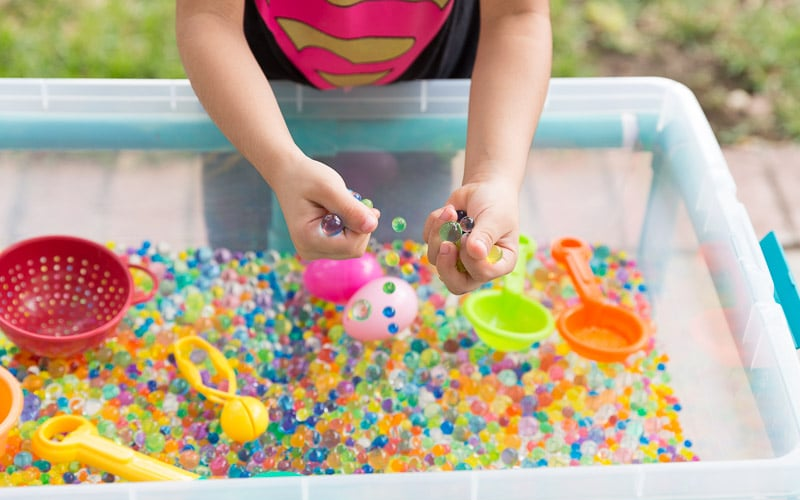
재료:
- Water beads
- Large bowl or bin
- Ladles, measuring spoons, and small cups
- Optional: plastic animals or toys for hidden surprises
단계:
- Place dry water beads in a large container and soak them in water overnight.
- Once fully expanded, drain the water and transfer the beads into a shallow bin.
- Add scooping and pouring tools for exploration.
- Invite your child to scoop, squish, and transfer beads between containers.
- Add hidden objects if desired to create a gentle search-and-find activity.
Animal Rescue Bin
This activity supports problem-solving skills, strengthens the pincer grasp, and introduces sorting and classification. It encourages critical thinking as children work to “rescue” animals hidden within a soft filler. The use of tongs or tweezers promotes finger strength and coordination, both of which are essential for self-care tasks like buttoning and writing.
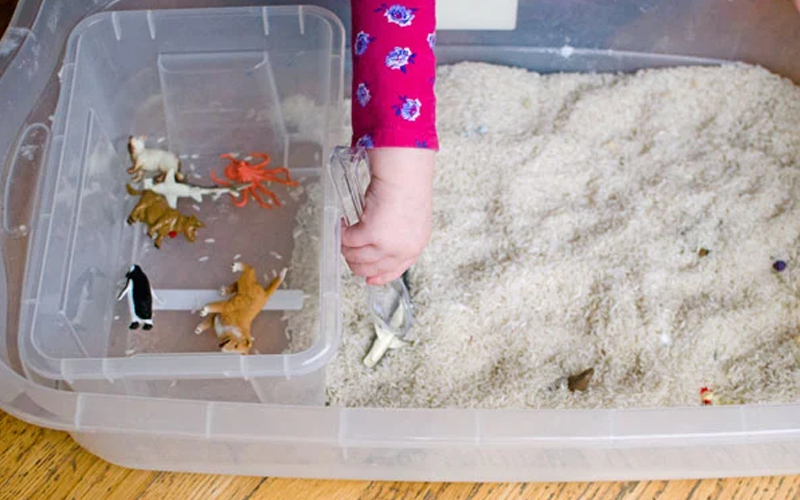
재료:
- Pom-poms, shredded paper, or dry oats
- Small plastic animal figures
- Tongs or tweezers
- Small containers for sorting
단계:
- Fill a large container with the chosen filler material.
- Hide animal toys throughout the bin, pressing them down so they’re not immediately visible.
- Give your child a pair of tongs and explain that their task is to find and rescue the animals.
- Are you constantly searching for pleasurable or meaningful ways to engage your toddler at home or in the classroom? Do
- Add challenges such as using one hand only or timing the rescue for fun.
Frozen Toy Rescue
This activity introduces scientific thinking through experimentation with temperature and melting. Children learn about cause and effect while also practicing patience and persistence. The sensory aspect of touching ice and warm water offers contrast and tactile stimulation. It’s also a fantastic opportunity to introduce new vocabulary like “freeze,” “melt,” “solid,” and “liquid,” making it a playful early science lesson.
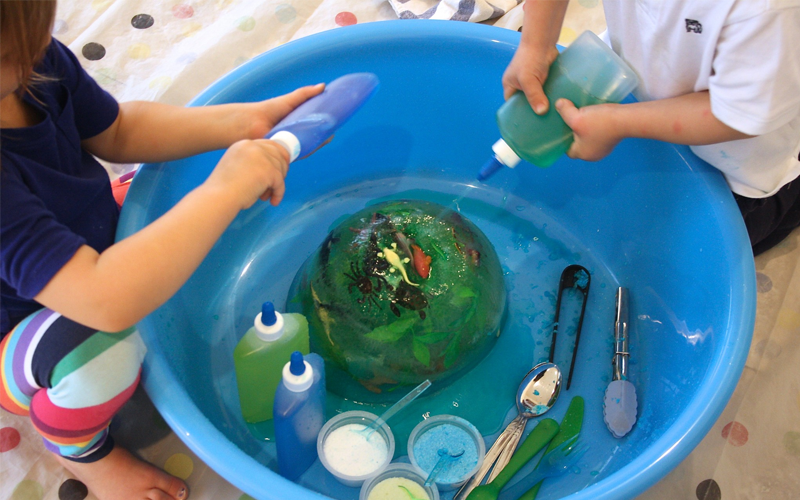
재료:
- Ice cube trays or plastic containers
- Small plastic toys
- Water
- Salt, warm water
- Droppers, squeeze bottles, or spoons
단계:
- Place small toys into containers and fill with water, then freeze overnight.
- Remove the frozen blocks and arrange them in a tray or bin.
- Give your child tools to explore how to melt the ice—salt, warm water in squeeze bottles, or droppers.
- Encourage experimenting with different techniques to free the toys.
- Discuss the changes in temperature, texture, and form during play.
Nature Discovery Tray
This activity builds a child’s connection to the natural world while developing observation, classification, and descriptive language skills. Handling different natural textures—like rough bark, smooth stones, or soft moss—enhances tactile awareness. It also encourages curiosity, mindfulness, and appreciation for seasonal change. This tray is handy for calm, focused play indoors after a nature walk.

재료:
- Leaves, pinecones, sticks, pebbles, acorns
- Small baskets, trays, or bowls
- 확대경
- Tweezers or child-friendly tongs
단계:
- Go for a nature walk and collect a variety of safe, clean natural items.
- Bring them home and lay them out on a tray.
- Invite your child to sort the items into categories—by texture, shape, or type.
- Use the magnifying glass to take a closer look at details like leaf veins or pinecone patterns.
- Encourage your child to describe what they see, feel, or smell, and let them create their own “nature museum.”
Pasta Sensory
Sorting by shape, size, or color teaches visual discrimination and categorization, early math and logic skills. Picking up small pasta pieces with fingers or tweezers strengthens the pincer grasp and supports hand-eye coordination. It also introduces children to independent thinking as they decide how to organize and make sense of what they see in front of them.
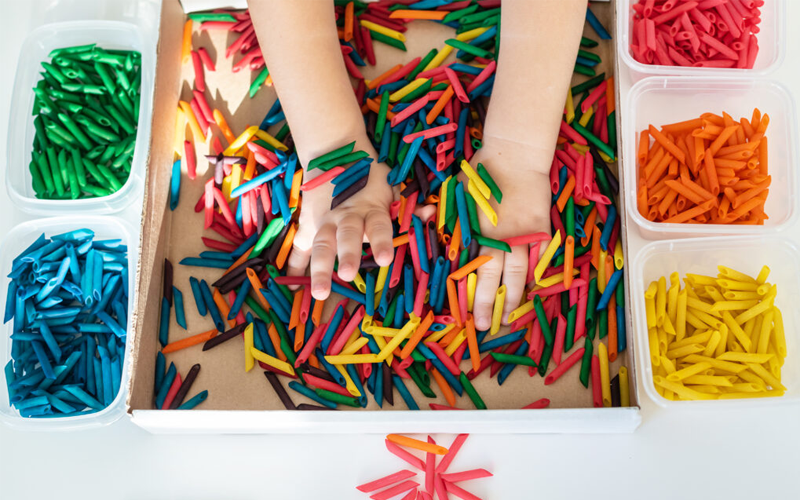
재료:
- Mixed dry pasta (e.g., penne, macaroni, bow tie)
- Small bowls or muffin tins
- Child-safe tweezers or fingers
단계:
- Pour a variety of pasta shapes into a large container or tray.
- Set out bowls or sections to sort into.
- Ask the child to group pasta by type, size, or color using their hands or tools.
- Add a counting challenge to extend the activity.
Color Sorting Bean Bin
This sensory bin builds color recognition, sorting skills, and early math logic. Children strengthen their visual discrimination while also practicing fine motor control through scooping and placing small objects. The task of organizing by color supports cognitive development and encourages independence and focus.
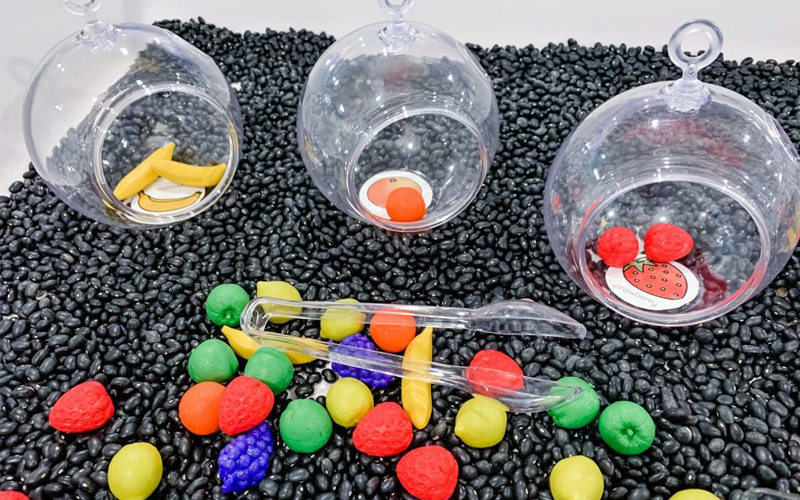
재료:
- Mixed colored dry beans (or dyed chickpeas)
- Small plastic cups or bowls
- A shallow plastic bin or tray
- Spoons, tweezers, or scoops
단계:
- Fill the bin with a colorful mix of dried beans or chickpeas.
- Place small cups or bowls around the bin for sorting by color.
- Provide tools like tweezers or scoops.
- Encourage the child to pick up one bean at a time and sort it into the correct cup.
Ocean-Themed Water
This water-based bin provides calming tactile stimulation and introduces early science themes like floating, sinking, and marine life. It also encourages storytelling and vocabulary development as children interact with sea animals and water movement.
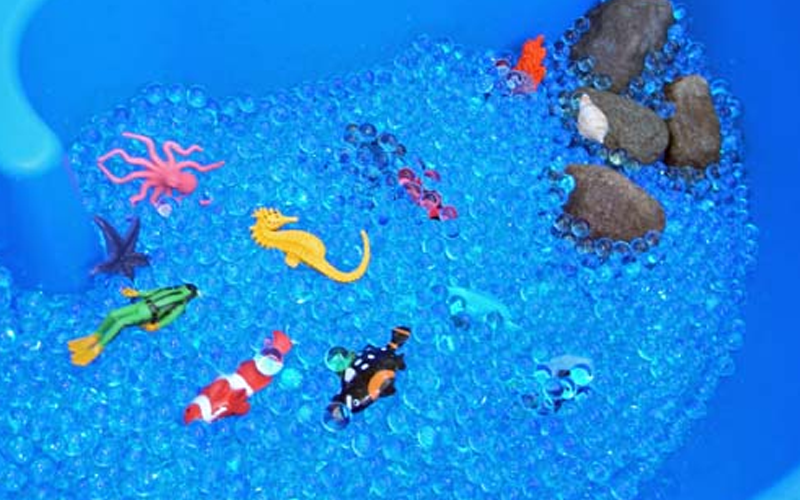
재료:
- Water
- Blue food coloring (optional)
- Small plastic sea animals, shells, or pebbles
- Measuring cups, ladles, or nets
- Clear bin or plastic tub
단계:
- Fill the bin halfway with clean water.
- Add a few drops of blue coloring if desired.
- Place sea animals, shells, and tools into the bin.
- Let children scoop, splash, and “rescue” animals from the sea while exploring textures.
Construction Site Bin
This setup supports imaginative play, coordination, and problem-solving. Children manipulate tools and move small materials, improving muscle control and spatial awareness. They also learn about real-world roles through pretend construction.
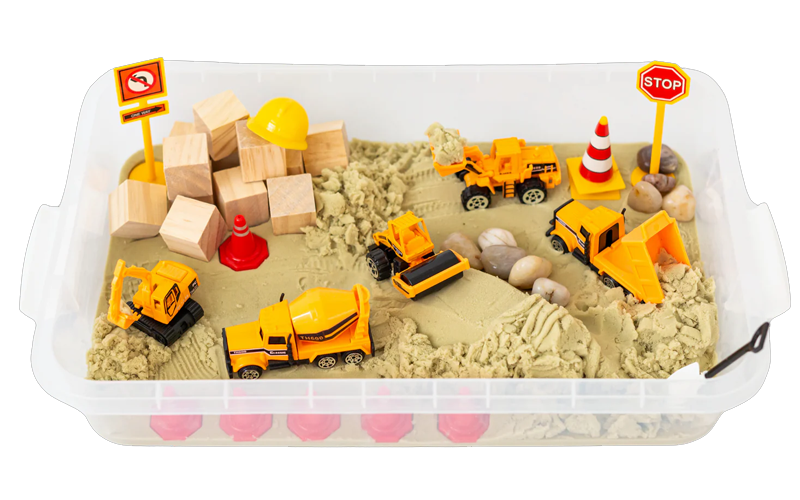
재료:
- Kinetic sand or dry brown rice
- Toy construction vehicles (excavators, dump trucks)
- Pebbles, mini bricks, or wood chips
단계:
- Pour the filler into a sturdy container.
- Add toy vehicles and building props.
- Set up small challenges like “move the rocks” or “dig a road.”
- Encourage storytelling and free play around building and digging.
Alphabet Discovery Bin
This activity combines tactile learning with early literacy exposure. Children practice recognizing letters while building memory, focus, and fine motor skills. It’s great for reinforcing phonics and letter identification through sensory exploration.
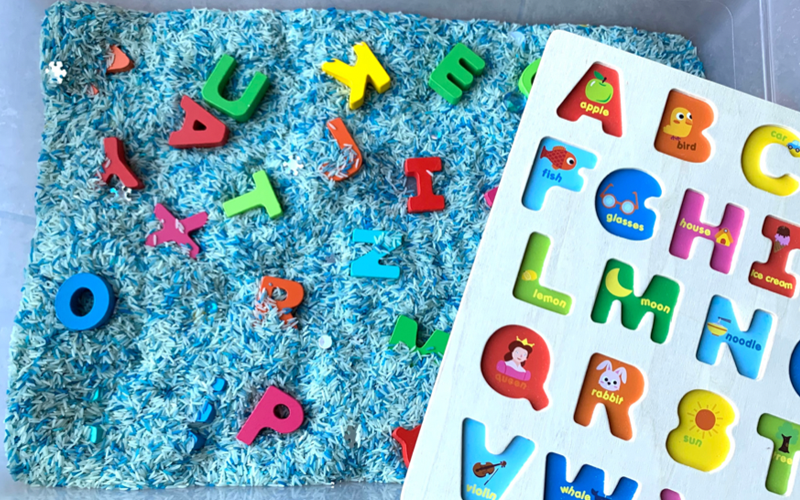
재료:
- Dry rice or shredded paper
- Plastic or foam alphabet letters
- Small containers
- Tongs or fingers
단계:
- Hide letter pieces throughout the filler inside the bin.
- Invite children to search for the letters using their hands or tongs.
- As they find each letter, have them name it or match it to a chart.
- Extend the activity by grouping vowels or spelling short words.
Baking-Themed Bin
This pretend baking setup supports role-playing, sequencing, and language development. It also strengthens hand coordination through scooping, mixing, and pouring actions—perfect for toddlers developing independence.
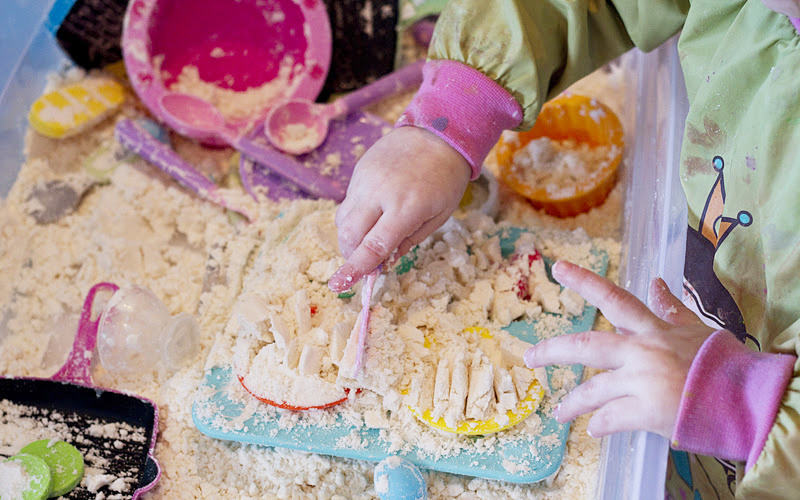
재료:
- Flour, oats, or cornmeal
- Measuring spoons, mixing bowls, cupcake liners
- Plastic eggs, measuring cups, play cookies
- Deep tray or bin
단계:
- Fill the bin with dry baking materials.
- Add pretend baking tools and ingredients.
- Encourage children to scoop, “crack” eggs, and “mix” recipes.
- Create a simple task like “make cupcakes” to guide their imaginative play.
Arctic Ice Exploration Bin
This cold-themed activity introduces temperature awareness and scientific thinking through sensory exploration. Children learn about melting, freezing, and environmental textures while enhancing hand coordination. The contrast between ice and warm water also helps with sensory regulation, especially for kids who enjoy strong tactile input.
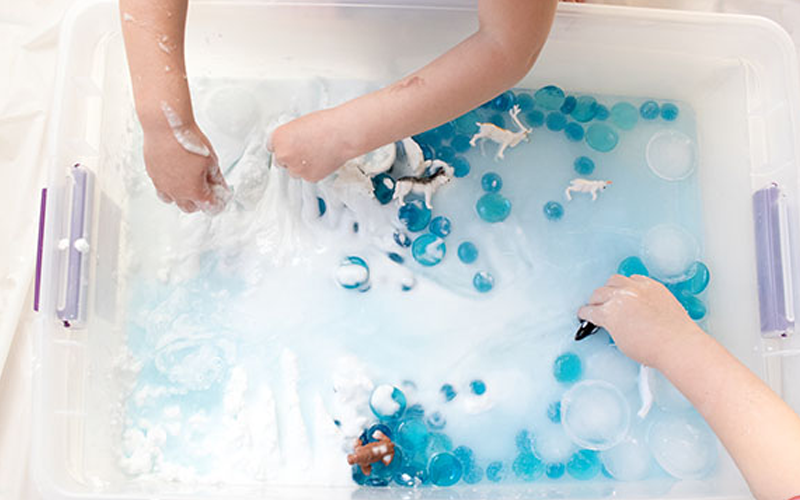
재료:
- Ice cubes (regular or shaped)
- Plastic arctic animals (polar bears, penguins, seals)
- Warm water in squeeze bottles
- Salt, droppers, small cups
단계:
- Place a layer of ice cubes in the bin.
- Add arctic animal figures on top and around the ice.
- Provide warm water bottles, salt, or droppers.
- Encourage the child to explore the ice, melt it slowly, and move animals across the “arctic” landscape.
Bug Hunt Dig Bin
This bin encourages investigation, critical thinking, and vocabulary development around insects and nature. It strengthens the pincer grasp and hand control as children dig and sort small objects. It’s also ideal for promoting curiosity and early science exploration in a fun, non-threatening way
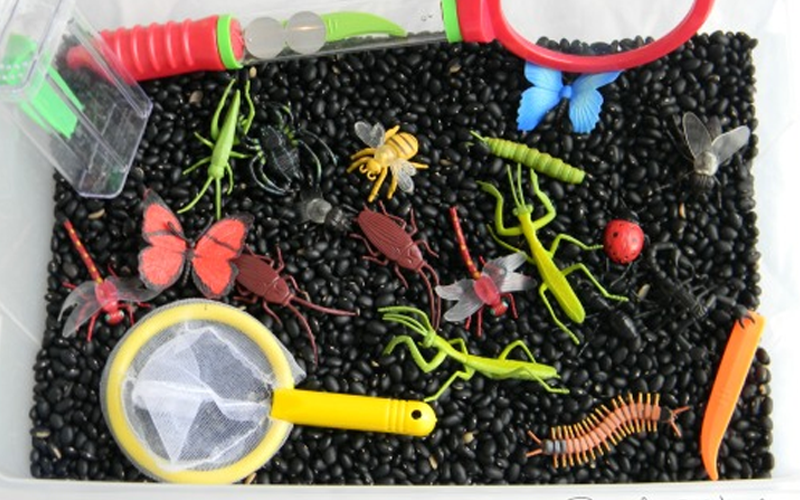
재료:
- Dry black beans, soil, or coffee grounds
- Plastic bugs (ladybugs, ants, beetles)
- Magnifying glass, tongs, sorting bowls
단계:
- Fill the bin with a dark filler to mimic soil.
- Hide the plastic bugs underneath and mix them in.
- Provide tools like tweezers or a magnifier.
- Ask the child to find and sort the bugs by type or color.
Pom-Pom Scoop and Transfer Bin
This activity supports color sorting, fine motor accuracy, and bilateral coordination. Scooping and transferring help toddlers build foundational skills for using utensils and writing tools. The softness of the materials makes it especially calming for children who need a gentler sensory experience.
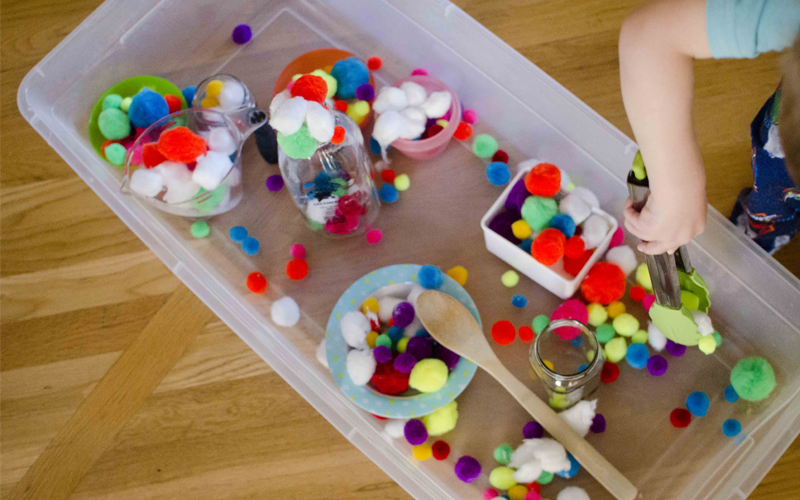
재료:
- Mixed-size pom-poms
- Ice cube tray or muffin tin
- Spoons, scoops, tongs
단계:
- Spread a variety of pom-poms in the bin.
- Place an ice cube tray nearby for sorting.
- Encourage the child to transfer pom-poms using different tools.
- Introduce extra challenges like sorting by size or counting aloud during play.
Magnetic Treasure Bin
This bin introduces children to magnetism through hands-on play, building curiosity and focus. It also refines fine motor skills and encourages cause-and-effect thinking as children discover which objects respond to the magnet.
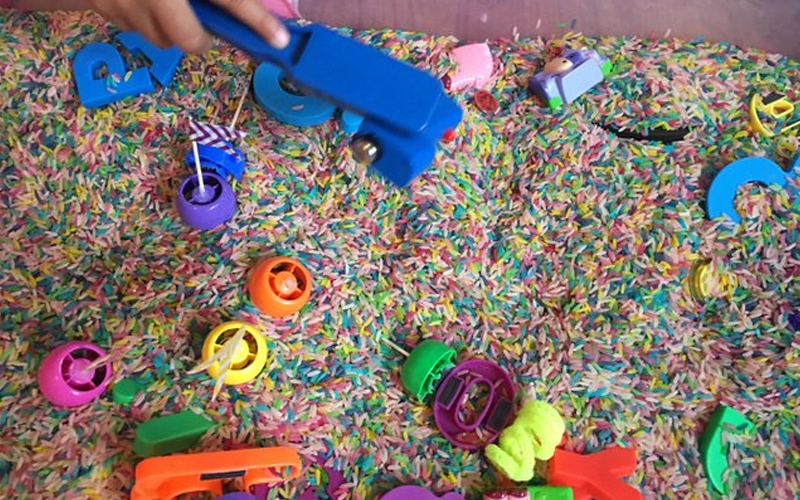
재료:
- Magnetic wand or child-safe magnet
- Dry rice, sand, or shredded paper
- Magnetic and non-magnetic items (paper clips, coins, bottle caps)
- Sorting bowls
단계:
- Fill the bin with your chosen filler.
- Hide various objects inside—some magnetic, some not.
- Hand the child a magnetic wand.
- Let them explore and collect “treasures,” then sort what the magnet picked up versus what it didn’t.
Birthday Party Bin
This cheerful bin encourages pretend play, role-taking, and social-emotional skills like sharing and celebration. Children practice fine motor actions like scooping and placing, while also developing language through imaginative scenarios.
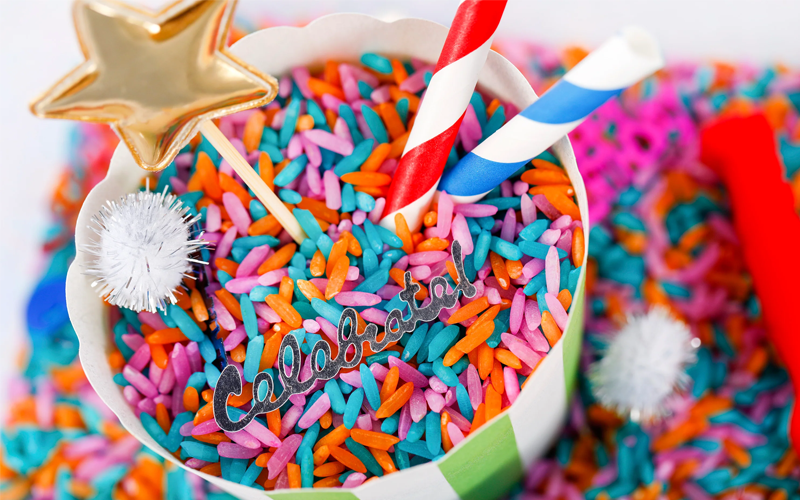
재료:
- Confetti paper or colored rice
- Plastic candles, cupcake liners, pom-poms (as “sprinkles”)
- Measuring spoons, small cups
단계:
- Fill the tray with confetti or other colorful filler.
- Add cupcake liners and pretend candles or toppings.
- Ask children to “bake” a birthday treat by scooping and decorating.
- Let them sing, blow out candles, and celebrate during the role play.
Sound Sensory Bin
This bin explores auditory awareness alongside tactile exploration. Children learn to differentiate sounds made by various objects while also building hand strength and coordination. It’s especially valuable for developing attention and sensory integration in a playful, discovery-driven way.
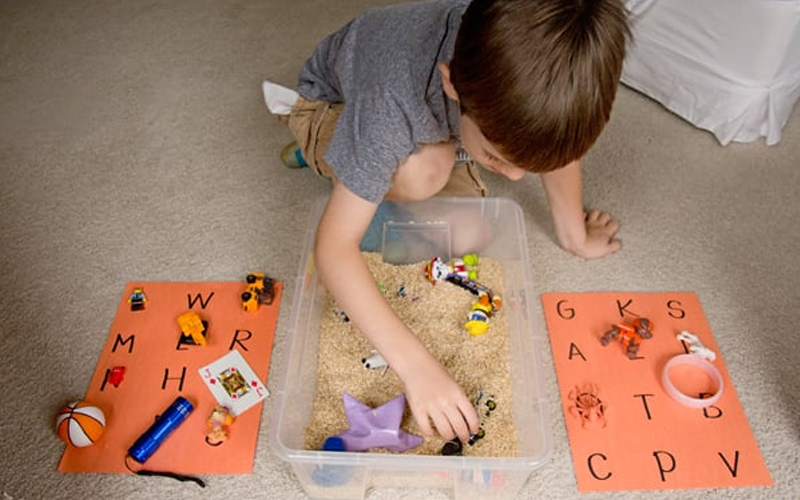
재료:
- A variety of small sound-making objects (bells, dried pasta in containers, maracas)
- Beans or lentils as filler
- Small boxes or cloth bags
단계:
- Fill the bin with dry filler and hide small sound items.
- Let children dig and discover one item at a time.
- Ask them to shake or tap each item and describe the sound.
- Group objects by loud/soft or high/low sounds.
Farm-Themed Bin
This activity encourages vocabulary building and storytelling around a familiar theme. Children practice recognizing animals, role-play daily farm life, and explore different textures. It also promotes categorization as they sort animals or match them to habitats
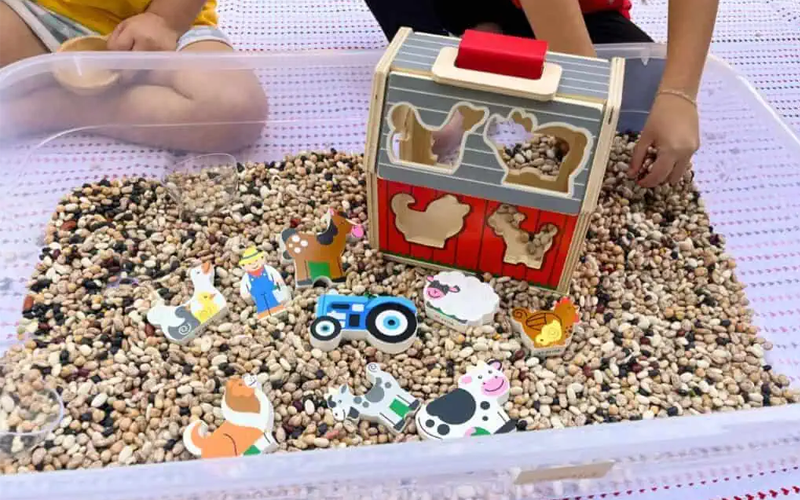
재료:
- Dry corn, oats, or straw-like filler
- Toy farm animals, fences, tractors
- Cups or baskets for sorting
단계:
- Add the filler to a large bin and mix in farm-themed toys.
- Set up small “pens” using cups or dividers.
- Invite the child to play freely or follow challenges like “bring the animals to the barn.”
- Encourage naming animals and making their sounds during play.
Glow-in-the-Dark Bin
This nighttime-friendly bin encourages exploration in a low-light setting, helping children build visual tracking and spatial awareness. It also reduces visual overstimulation while keeping play exciting. The glow effect adds mystery and wonder, inspiring storytelling, scientific questioning, and focus during quiet hours.
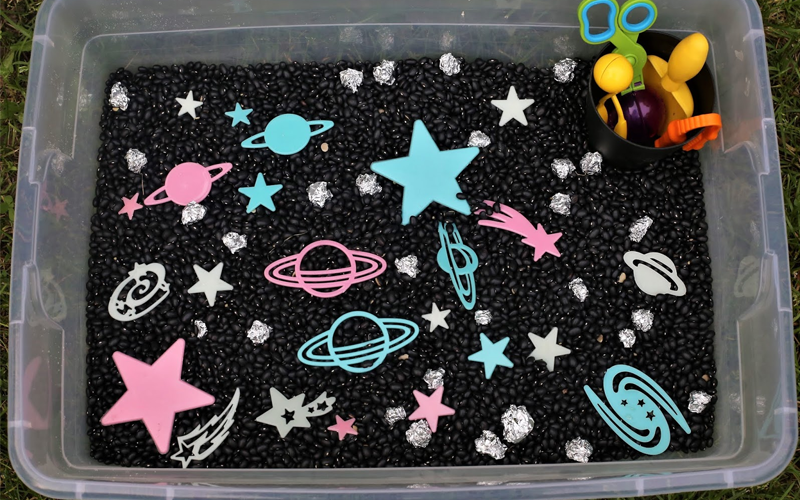
재료:
- Glow-in-the-dark stars, beads, balls
- Dry black beans or dark rice
- Small UV flashlight (optional)
- Tongs, clear cups
단계:
- Fill the bin with black beans or a dark filler base.
- Add glow-in-the-dark objects and mix thoroughly.
- Dim the room lights and offer a flashlight if available.
- Encourage children to search for glowing items, group them by shape, or create “constellations.”
Alphabet Soup Bin
This playful activity blends early literacy with sensory exploration. Children are exposed to letter shapes in a relaxed, hands-on environment. It supports letter recognition, sound association, and language development while also improving fine motor coordination through scooping, stirring, and pouring actions.
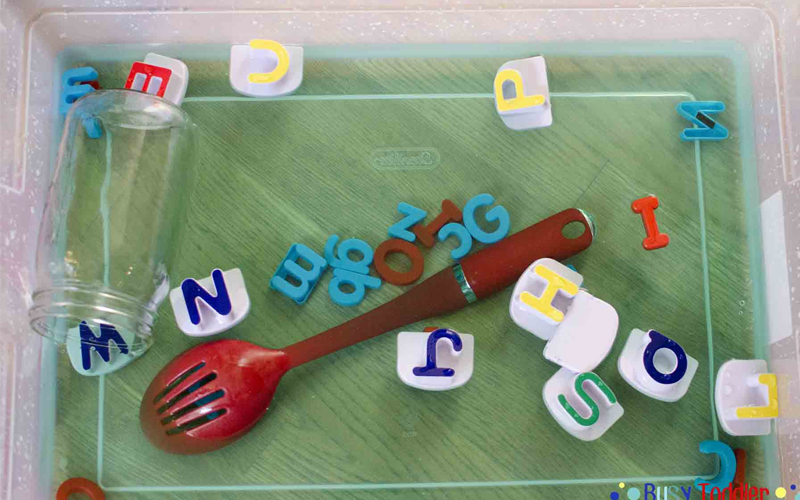
재료:
- Plastic or foam letters
- Water
- Large mixing bowl or bin
- Ladles, slotted spoons, soup pots or bowls
- Optional: pretend vegetables or toy food
단계:
- Fill a bin with water and add plastic letters.
- Mix in pretend veggies or food items for fun.
- Give children ladles and pots to “cook” their alphabet soup.
- Please encourage them to find specific letters or spell simple words as they scoop.
Garden Sensory Bin
This nature-inspired bin nurtures curiosity about the environment and life cycles. It supports hand strength and coordination through digging and planting motions, and introduces vocabulary around gardening, bugs, and plants. It also promotes care and empathy as children tend to their garden.

재료:
- Dry black beans (as soil)
- Artificial flowers, plastic veggies, or toy bugs
- Mini gardening tools or spoons
- Baskets or pots
단계:
- Fill a bin with black beans to represent soil.
- “Plant” flowers and vegetables by pushing them into the soil.
- Let children dig, plant, or harvest using small tools.
- Extend with sorting or matching activities based on flower types or colors.
Pirate Treasure Bin
This adventurous bin encourages imagination, problem-solving, and role-play. Children practice hand control while searching for treasures and sorting them. It also supports storytelling, early math (counting coins), and cooperation during shared play.
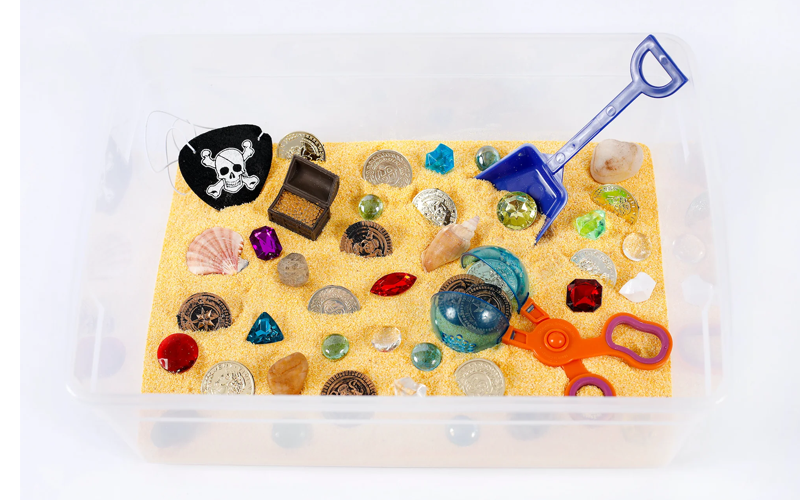
재료:
- Kinetic sand or brown rice
- Plastic gold coins, mini jewels, toy treasure chests
- Small scoops, brushes, and sifters
- Pirate hat or map (optional)
단계:
- Fill the bin with the chosen filler.
- Hide coins and jewels underneath.
- Invite children to dig and collect treasure using tools.
- Enhance with pirate-themed storytelling or coin-counting challenges.
Rainbow Color Scoop Bin
This is one of the most visually stimulating sensory bins for toddlers, promoting color recognition, coordination, and early categorization. Children improve their fine motor skills by scooping and sorting, while the bright materials keep their attention engaged. It’s a simple way to combine visual learning with hands-on exploration.
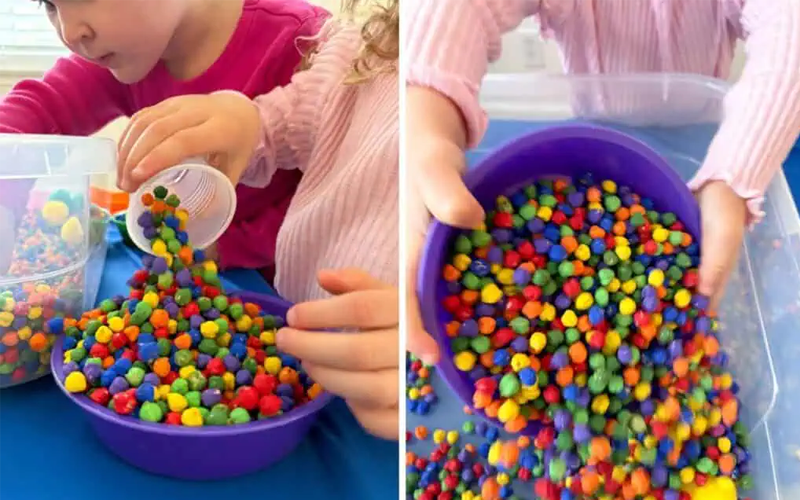
재료:
- Dyed rice in rainbow colors
- Small bowls or sorting trays
- Spoons, scoops, tongs
단계:
- Layer different colored rice in the bin.
- Place small sorting bowls nearby.
- Encourage children to scoop and separate colors.
- Ask them to name each color aloud or match to colored cups.
Fizzy Science Bin
This sensory and science combo stimulates curiosity and introduces early chemical reactions. As a hands-on STEM option among sensory bins for toddlers, it also supports cause-and-effect thinking and encourages descriptive language.
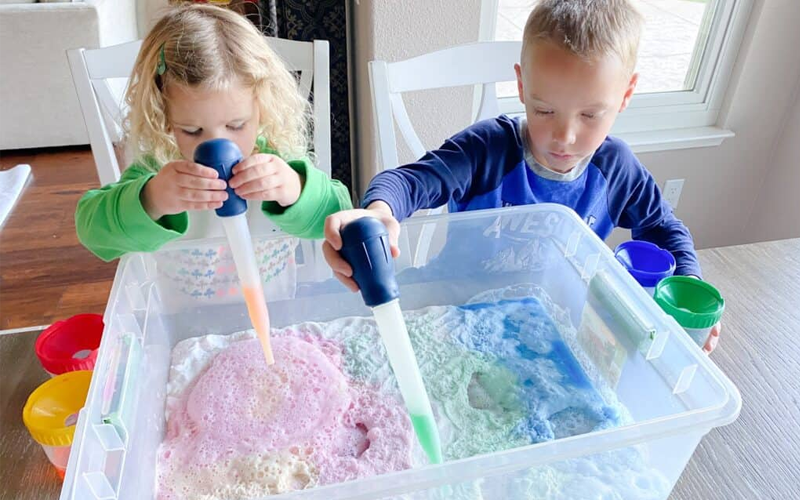
재료:
- Baking soda
- Vinegar
- Food coloring
- Plastic pipettes or squeeze bottles
단계:
- Spread baking soda in a shallow bin.
- Mix food coloring with vinegar in small cups.
- Let toddlers drop vinegar onto baking soda using pipettes.
- Watch the fizz and discuss colors, reactions, and sounds.
Beach Day Sensory Bin
Perfect for summer or pretend vacations, this setup builds vocabulary, imaginative play, and texture exploration. Among the most relaxing sensory bin ideas for toddlers, it mimics real-world environments in a safe, creative format.
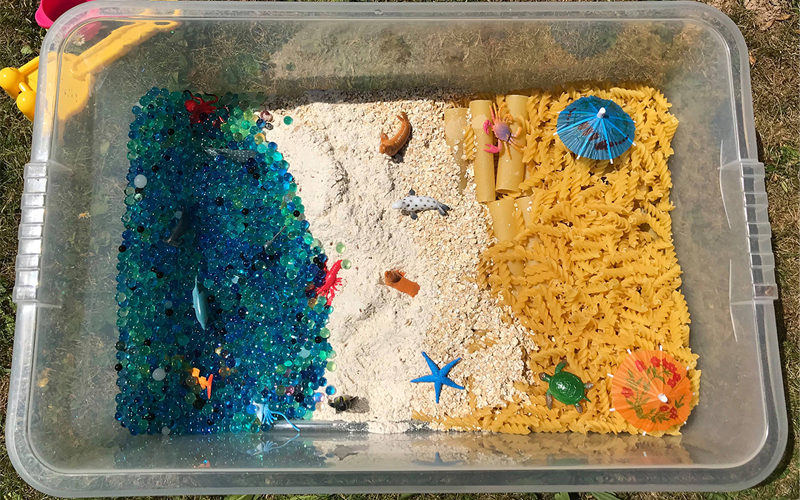
재료:
- Kinetic sand or play sand
- Seashells, mini umbrellas, plastic sea creatures
- Scoops, shovels, cups
단계:
- Pour sand into the bin and add beach-themed items.
- Let toddlers dig, scoop, and build.
- Create pretend beach scenes or play matching games with sea animals.
- Encourage storytelling: “What can you find at the beach?”
Weather-Themed Bin
This creative bin helps toddlers explore weather concepts through hands-on, visual play. It supports language development by encouraging weather-related vocabulary like “rain,” “sun,” and “cloud.” As one of the more thematic sensory bins for toddlers, it enhances symbolic thinking and encourages storytelling.
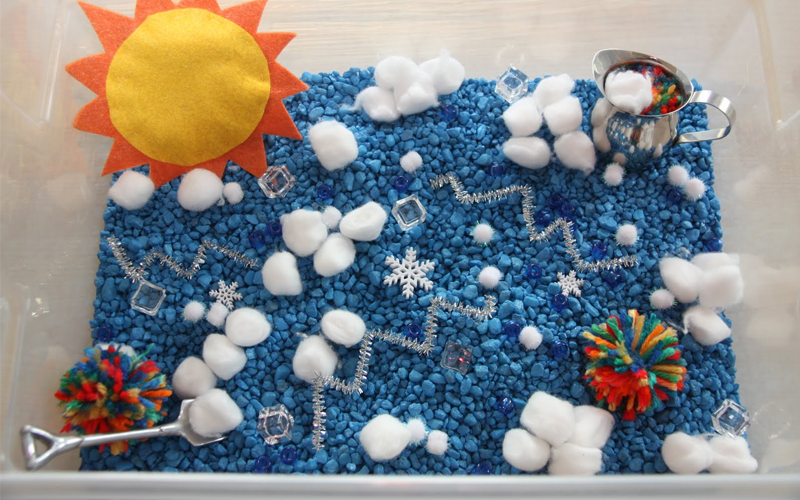
재료:
- Cotton balls (clouds), blue water beads (rain), yellow pom-poms (sun)
- Small plastic weather icons (umbrellas, thermometers)
- Cups, scoops, tweezers
단계:
- Create different “weather zones” in the bin using textured items.
- Let the child explore each section, naming the weather types.
- Ask questions like, “What happens when it rains?”
- Add role-play—pretend to be the sun or the wind.
Moon Rock Bin
This space-themed activity introduces toddlers to outer space while encouraging fine motor and science-based thinking. It ranks among the most imaginative sensory bins for toddlers, promoting descriptive language, exploration, and spatial reasoning.
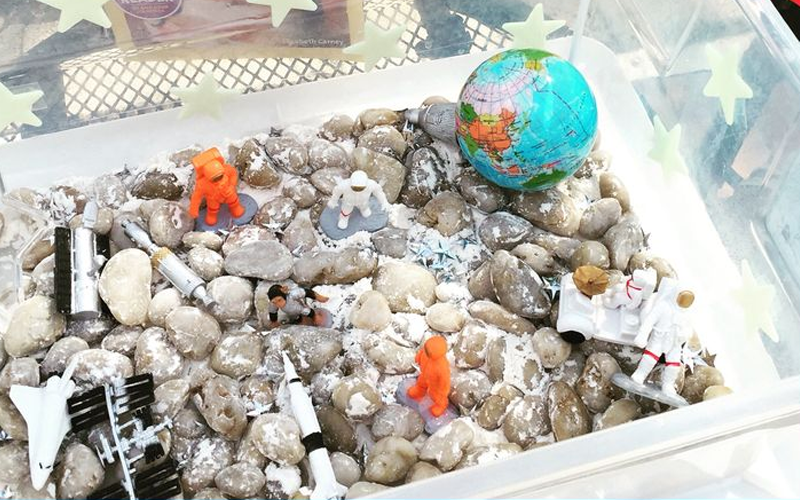
재료:
- Foil-wrapped balls (moon rocks)
- Black beans or sand
- Toy astronauts, rockets
- Scoops, magnifying glass, flashlights
단계:
- Fill the bin with black beans or dark sand.
- Hide moon rocks and space toys inside.
- Give your toddler tools to explore and “collect” rocks.
- Turn off the lights and use flashlights for dramatic play.
Fruit Salad Sensory Bin
This pretend cooking bin teaches healthy food choices, sorting, and creative expression. One of the tastiest-looking sensory bins for toddlers, it helps children recognize fruit names, colors, and shapes while using fundamental kitchen tools to practice life skills.
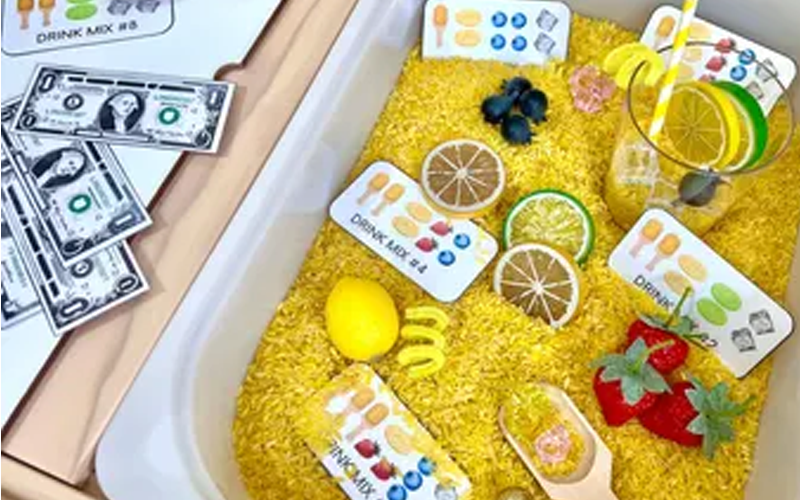
재료:
- Foam or plastic fruit toys
- Colored pom-poms (as fruit pieces)
- Bowls, tongs, measuring spoons
단계:
- Fill the bin with pretend fruit items.
- Add tools for scooping, “mixing,” and serving.
- Encourage your toddler to name fruits and sort by color or type.
- Play restaurant or chef to extend language use.
Bubble Bin
Bubbles offer multisensory stimulation—touch, sight, sound—all in a straightforward activity. This is one of the most calming and fun sensory bins for toddlers, promoting hand-eye coordination, concentration, and emotional regulation through repeated scooping and popping.
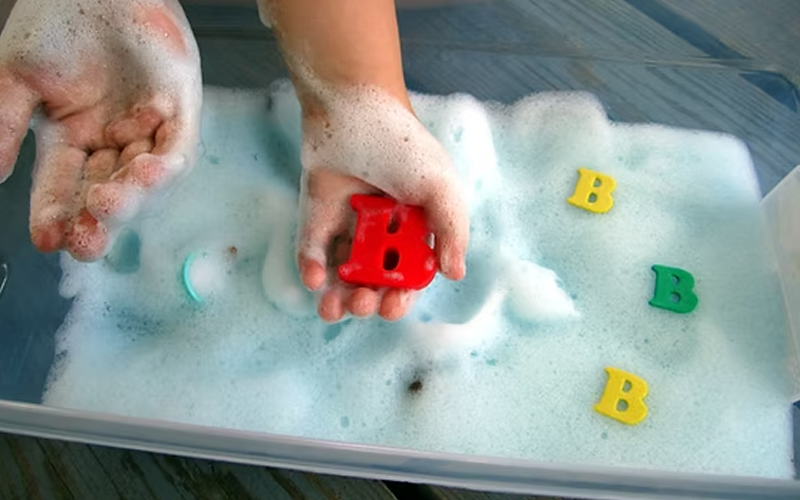
재료:
- Warm water
- Dish soap or bubble mix
- Whisks, straws, spoons, and toy animals
단계:
- Add warm water and soap to a bin.
- Whisk until bubbles form.
- Add toys to the bin for washing or role-play.
- Let toddlers scoop bubbles, blow through straws, or “give a bubble bath.”
Dinosaur Dig Bin
This bin fuels curiosity and imagination, turning toddlers into little paleontologists. As one of the most exciting sensory bins for toddlers, it promotes problem-solving, storytelling, and tactile exploration through digging, brushing, and “excavating” dinosaur bones.
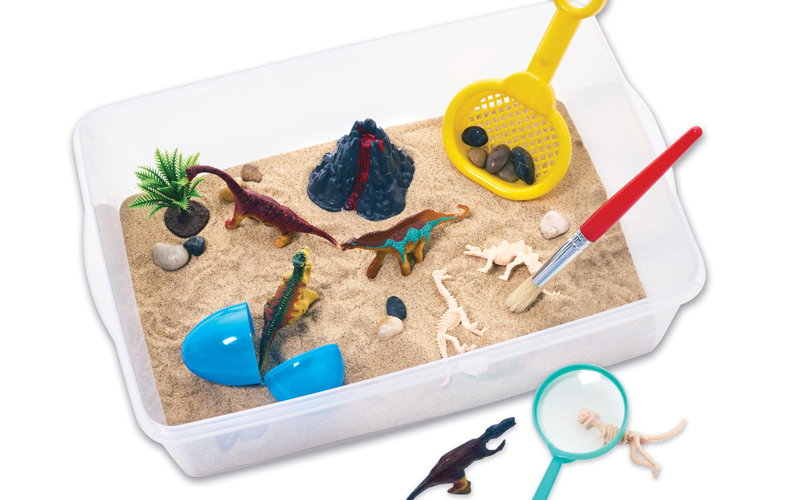
재료:
- Kinetic sand or coffee grounds (as dirt)
- Small plastic dinosaurs or fossil pieces
- Brushes, scoops, mini shovels
단계:
- Fill the bin with sand or grounds.
- Hide dinosaur toys or bones beneath the surface.
- Provide brushes and tools for digging and uncovering.
- Let toddlers “discover” fossils and talk about each dinosaur they find.
Mermaid Lagoon Bin
This magical setup supports creative thinking, fine motor coordination, and sensory exploration through water play and fantasy storytelling. It’s among the most imaginative sensory bins for toddlers, encouraging self-expression and social-emotional learning through pretend scenarios.
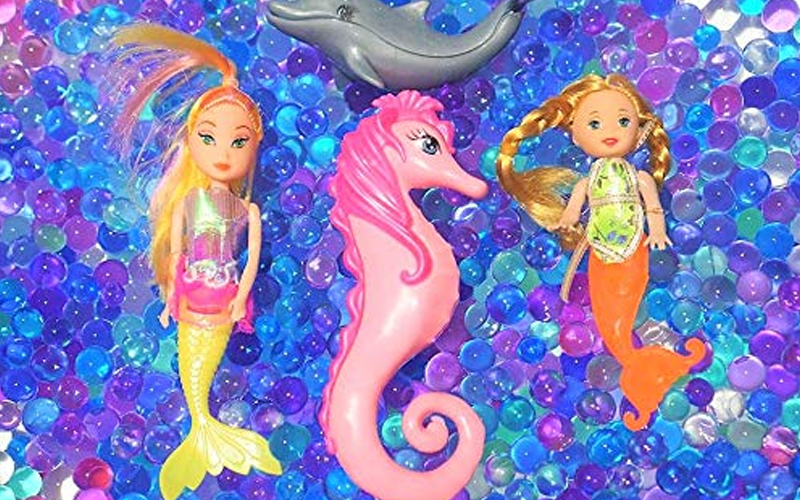
재료:
- Water
- Blue food coloring
- Shells, gems, plastic mermaids or fish
- Nets, cups, and small boats
단계:
- Fill a bin with blue-tinted water.
- Add mermaids, sea creatures, and decorative elements.
- Let children scoop water, rescue sea friends, or tell stories.
- Ask, “What lives in the lagoon? Can you build a mermaid castle?”
Shapes & Sorting Bin
This is one of the best educational sensory bins for toddlers, combining tactile play with early geometry. It helps children recognize shapes, categorize by type, and improve fine motor skills through grabbing, matching, and organizing.
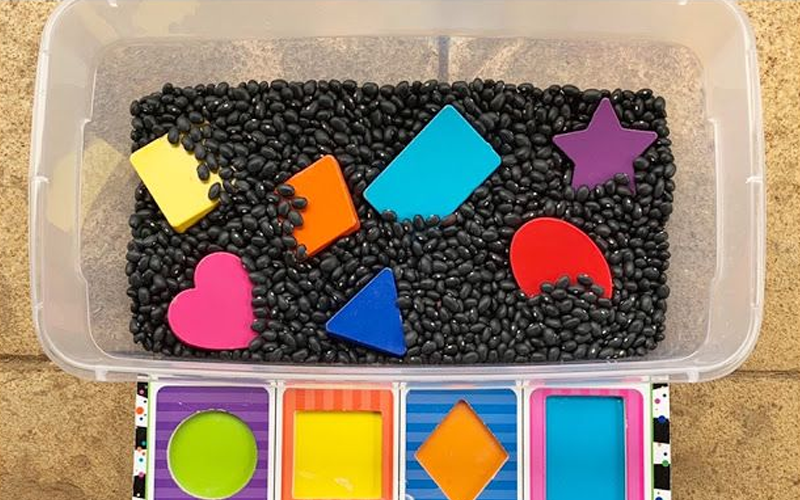
재료:
- Foam or wooden shapes
- Dry rice or shredded paper
- Sorting bowls or mats
- Tongs, spoons
단계:
- Mix the shapes into the filler inside the bin.
- Give your toddler sorting trays labeled with each shape.
- Please encourage them to find and match by shape.
- Add discussion prompts like, “What has three sides?” or “Find all the circles.”
Alphabet Bean Bin
This literacy-focused setup supports letter recognition, sound awareness, and vocabulary expansion. As one of the most effective language-based sensory bins for toddlers, it makes learning letters tactile, visual, and fun, especially helpful for toddlers just starting with phonics.
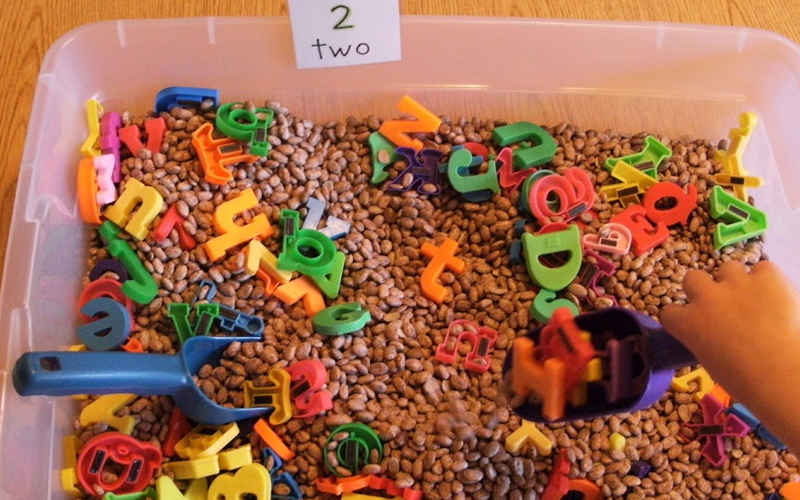
재료:
- Dry beans or chickpeas
- Plastic or foam alphabet letters
- Cups, tweezers, tongs
- Alphabet matching cards
단계:
- Mix alphabet letters into the bin with the dry filler.
- Invite toddlers to dig and find one letter at a time.
- Match letters to flashcards or alphabet mats.
- Sound out the letters as they’re found to reinforce learning.
Camping Adventure Bin
This creative theme brings nature indoors while supporting storytelling, sequencing, and pretend play. One of the most imaginative sensory bin ideas for toddlers, it teaches camping-related vocabulary and helps develop fine motor skills through hands-on interaction with miniature props.
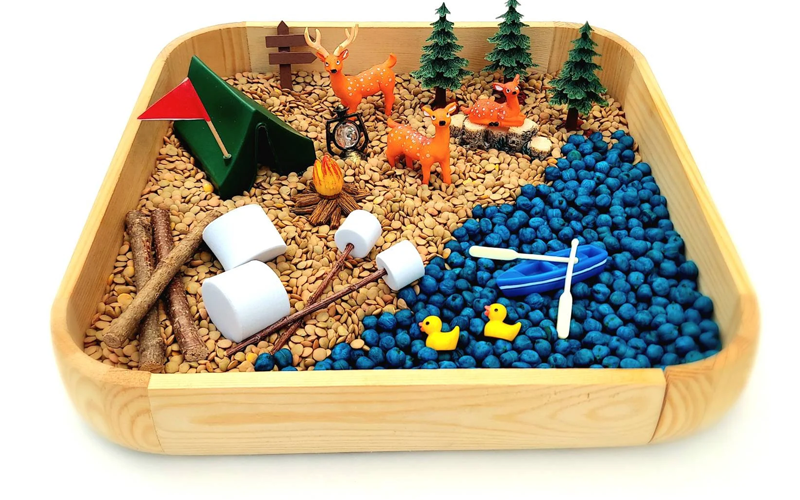
재료:
- Brown rice or oats (ground), green felt (grass), small rocks
- Toy tents, campfires, mini logs, animal figures
- Scoops, baskets
단계:
- Create zones: campsite, trail, grassy area.
- Add camping props and figures.
- Let your child explore, set up the camp, and “go on a hike.”
- Prompt with questions like “What do we do at a campfire?”
Pet Care Bin
This bin encourages empathy, role-play, and understanding of animal care. It’s a gentle introduction to responsibility and routine, making it one of the most emotionally engaging sensory bins for toddlers. Children build fine motor control while “feeding,” “brushing,” and organizing supplies for their toy pets.
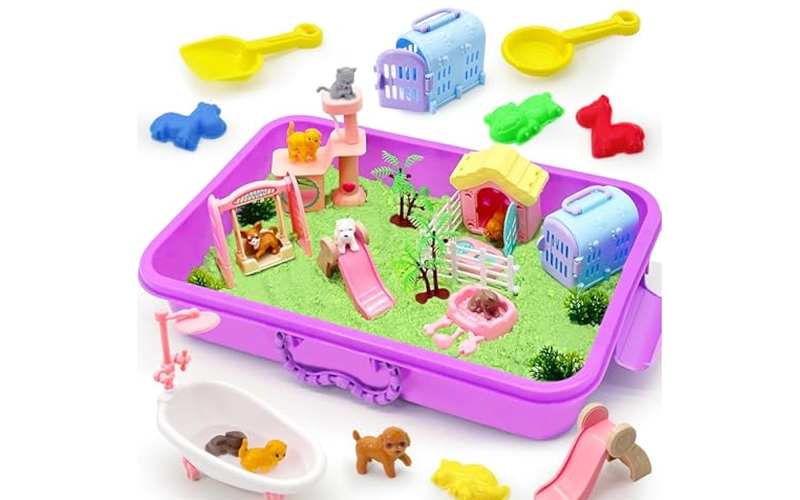
재료:
- Toy pet animals (dogs, cats, rabbits)
- Pet food scoops, small bowls, brushes
- Rice or pom-poms as pretend food
단계:
- Fill the bin with your pretend pet food filler.
- Add toy pets and accessories.
- Let children “feed,” groom, and care for each pet.
- Encourage language like “The puppy is hungry,” or “Brush the cat gently.”
Numbers & Counting Bin
This math-focused activity supports number recognition, counting, and early one-to-one correspondence. It’s one of the most foundational sensory bins for toddlers beginning to understand quantities and numerals. It also builds sorting and comparison skills.
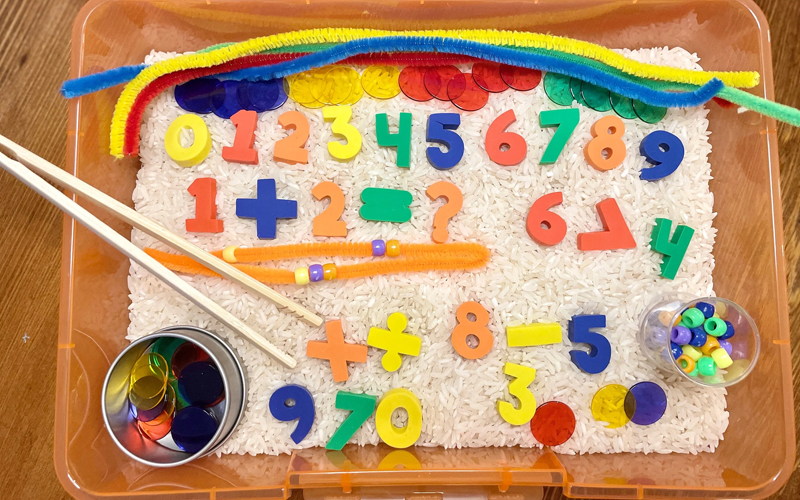
재료:
- Dry pasta or lentils
- Number cards or foam numbers (1–10)
- Small items for counting (beads, buttons, pom-poms)
단계:
- Mix filler with numbers and counters.
- Invite children to find a number, then count out matching items.
- Use number cards for matching or simple equations.
- Extend by sorting by size, color, or creating patterns.
Shredded Paper Bin
This is one of the easiest and most affordable sensory bins for toddlers, yet it offers rich tactile stimulation and fine motor development. Toddlers enjoy crumpling, digging, and searching through the lightweight texture, which helps build finger strength and bilateral coordination. It also encourages pretend play and storytelling.
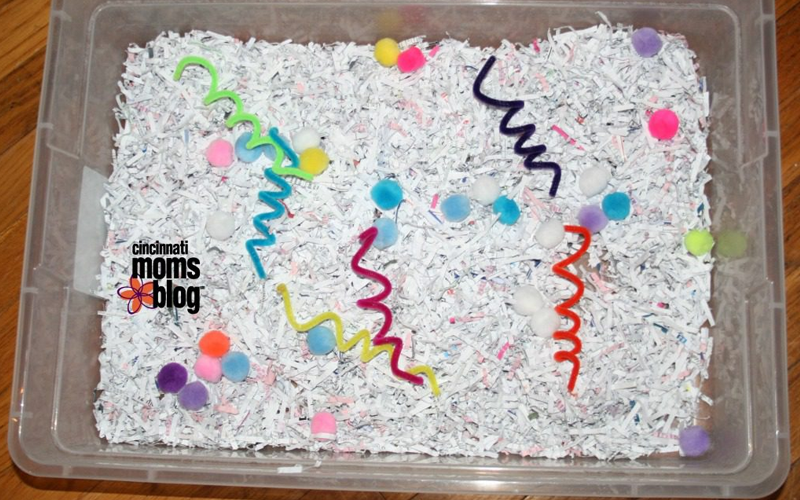
재료:
- Shredded paper (colored or plain)
- Small toys (animals, letters, cars)
- Scoops, tongs, bowls
단계:
- Fill the bin with shredded paper.
- Hide toys or letters underneath the paper.
- Provide tools for digging, grabbing, or sorting.
- Ask your toddler to search for specific objects or colors.
Leaves Bin
This bin connects toddlers to the natural world while stimulating multiple senses—touch, sight, and even smell. It’s an ideal autumn-themed sensory bins for toddlers, promoting observation skills, environmental awareness, and vocabulary development around nature.
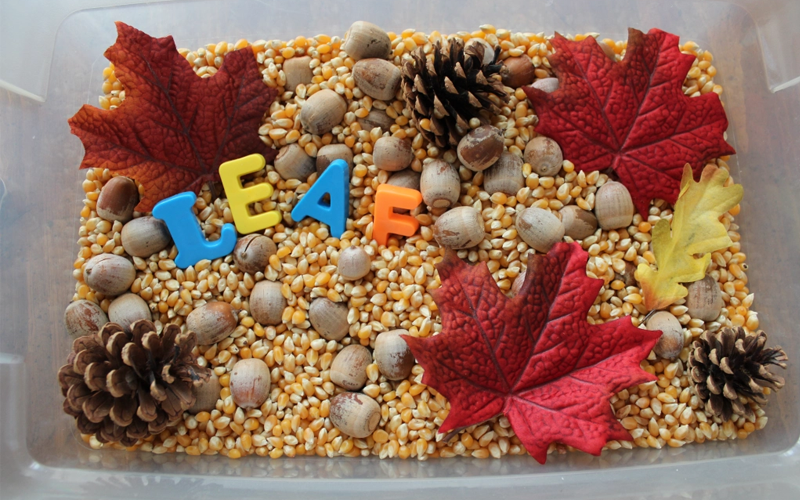
재료:
Dry leaves (real or artificial)
Acorns, pinecones, twigs
Magnifying glass, tweezers, small baskets
단계:
- Place dry leaves and natural items in the bin.
- Mix them for texture variety.
- Let toddlers explore, sort, or match items.
- Use a magnifier to examine patterns and discuss textures.
Corn Meal Bin
The soft, grainy texture of cornmeal is soothing and encourages calm sensory play. This bin helps toddlers with scooping, pouring, and tracing—perfect for writing preparation. Among sensory bins for toddlers, it’s great for focusing on early literacy and motor control.
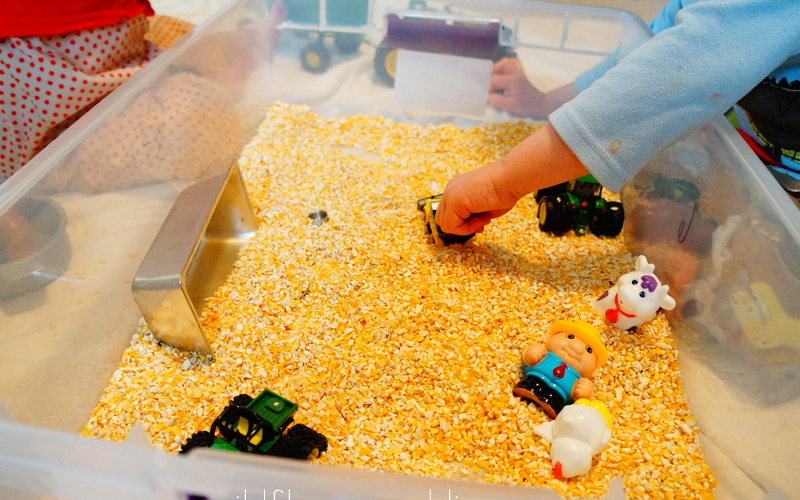
재료:
- Cornmeal
- Measuring cups, funnels, trays
- Toy vehicles or alphabet stamps
단계:
- Pour cornmeal into a deep bin.
- Add spoons and toys for digging and pouring.
- Show how to draw letters or shapes in the cornmeal.
- Let toddlers experiment freely or copy letter shapes.
Oobleck Bin
Oobleck is a non-Newtonian fluid that provides a one-of-a-kind sensory experience. As one of the most fascinating sensory bins for toddlers, it promotes science learning, curiosity, and a deep sensory response to pressure, resistance, and texture.
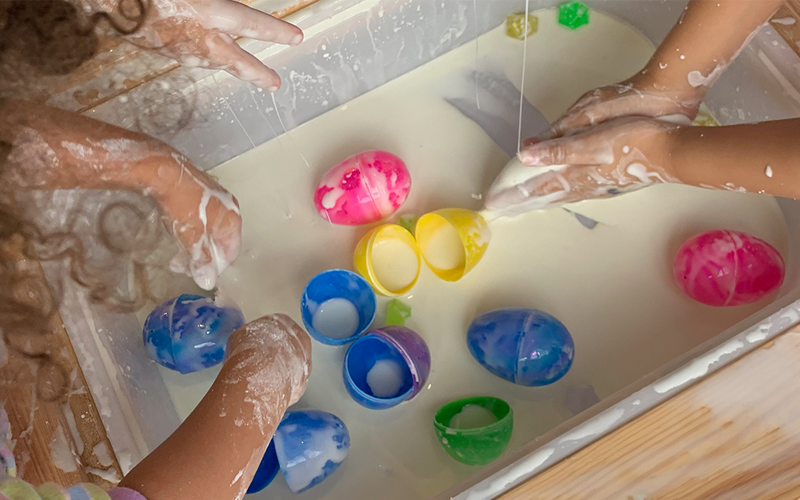
재료:
- Cornstarch
- Water
- Food coloring (optional)
- Cups, scoops, toys
단계:
- Mix 2 parts cornstarch with 1 part water in a bin.
- Add coloring if desired.
- Let children scoop, squeeze, and play.
- Discuss how it feels soft when touched gently and solid when pressed.
Magnifying Glass Bin
This is an excellent tool for visual exploration and science learning. It encourages close observation, vocabulary building, and focus, making it one of the most exploratory sensory bins for toddlers. Children feel like little scientists discovering hidden details.
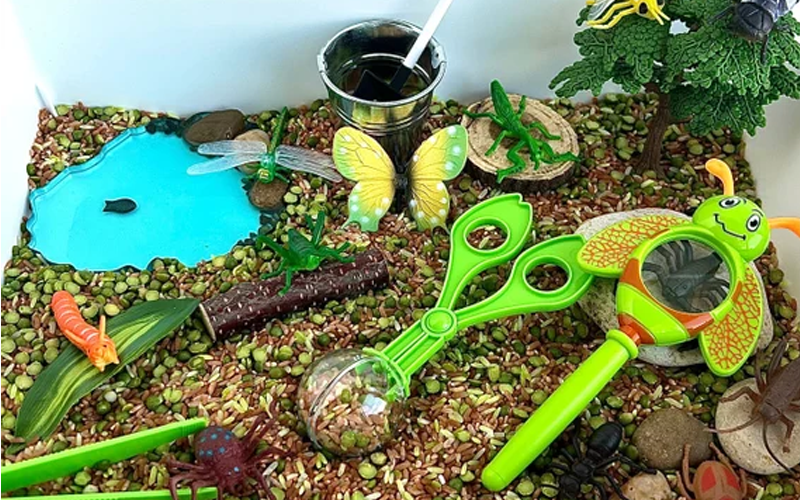
재료:
- Items with texture or detail (buttons, leaves, fabric, shells)
- Magnifying glasses
- Labels or cards
단계:
- Place various small objects with textures in the bin.
- Hand out magnifying glasses.
- Let children inspect each item closely.
- Ask open-ended questions like “What do you see?” or “How is this one different?”
Muddy Monster Truck Bin
This bin combines sensory mess with action-based play. Toddlers build strength, coordination, and creativity as they push trucks through the “mud.” Among sensory bin ideas for toddlers, this one supports gross motor play and introduces cause-and-effect through tracks and marks.
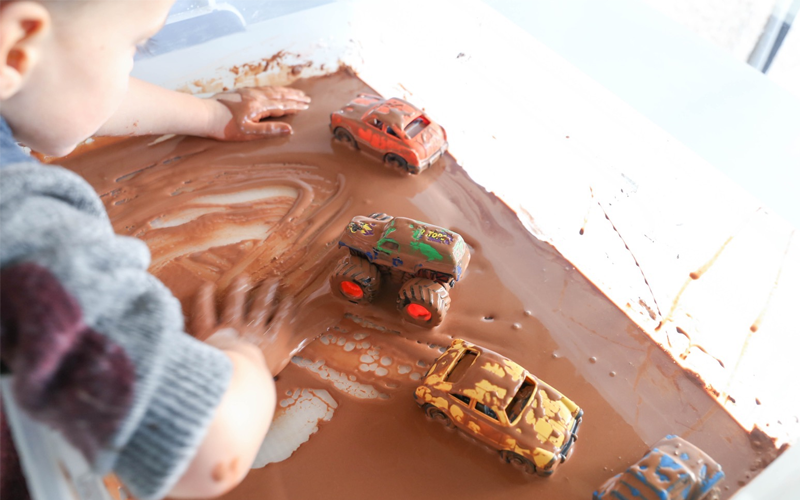
재료:
- Instant chocolate pudding or mud-like mix
- Toy monster trucks or cars
- Spoons, rags, and small towels
단계:
- Mix the pudding and spread it across the bin.
- Add toy trucks and ramps.
- Let children drive trucks, make tracks, and “race through mud.”
- Clean-up becomes part of the fun with water play afterward.
Oatmeal Bin
This gentle and edible-safe filler is perfect for younger toddlers. It offers soft tactile stimulation and encourages scooping, stirring, and pouring. It’s one of the best sensory bins for toddlers who are new to sensory play or prone to mouthing materials.
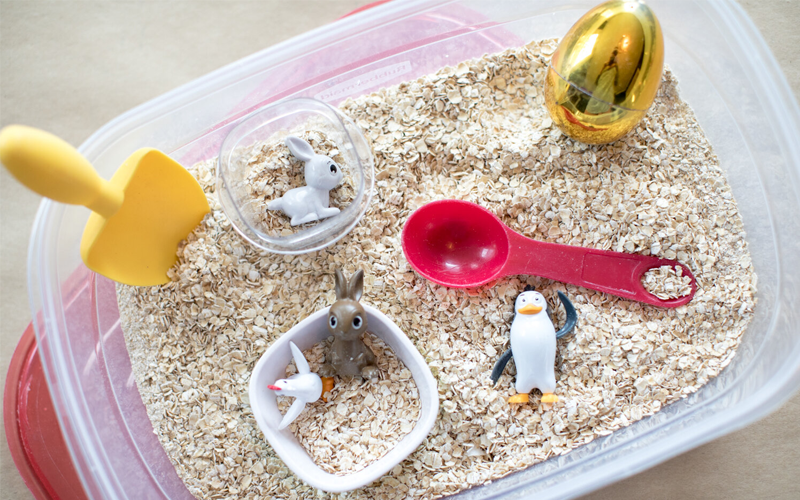
재료:
- Dry oats
- Spoons, cups, bowls
- Toy animals or utensils
단계:
- Pour oats into the bin.
- Add scoops, cups, and a few toys.
- Encourage toddlers to stir, pour, or “cook.”
- Extend the activity by pretending to make oatmeal recipes.
Chickpea Foam Bin
Chickpea foam is soft, light, and safe—ideal for messy, hands-on sensory bins for toddlers. It supports tactile processing, hand strength, and pretend play. It also helps sensory-sensitive children get comfortable with wet, squishy textures in a controlled setting.
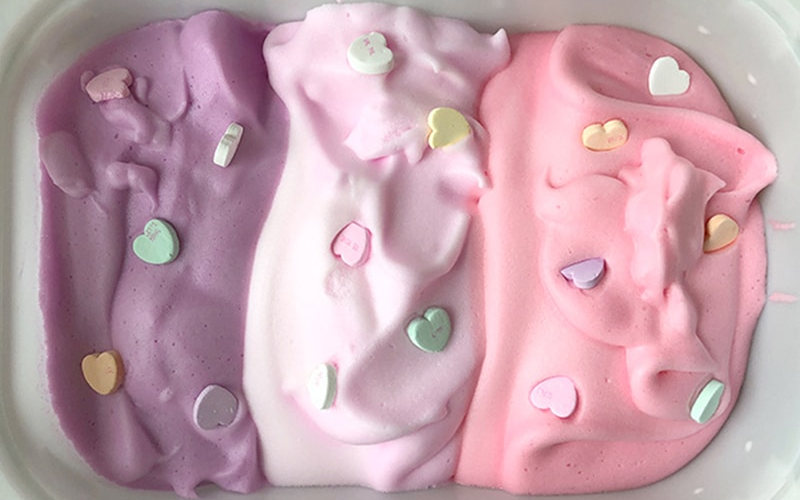
재료:
- Aquafaba (liquid from canned chickpeas)
- Hand mixer
- Food coloring (optional)
- Cups, spoons, scoops
단계:
- Whip chickpea water with a mixer until it forms a stiff foam.
- Add coloring if desired and transfer to the bin.
- Provide tools for scooping, transferring, or hiding small objects.
- Let toddlers explore freely—it’s easy to clean and taste-safe!
Flower Petal Bin
This beautifully scented and colorful bin stimulates multiple senses at once—touch, sight, and smell. As one of the most calming and nature-inspired sensory bins for toddlers, it encourages mindfulness, gentle movement, and creativity. It’s beneficial for quiet time, emotional regulation, or language development through descriptive play.
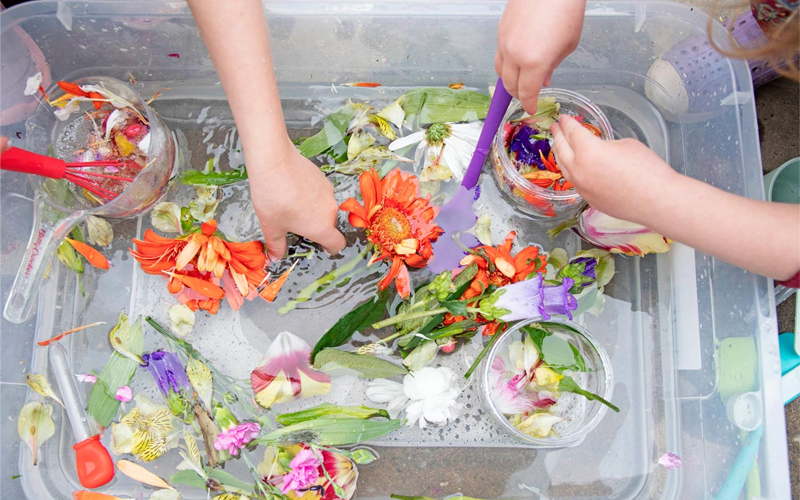
재료:
- Real or dried flower petals (rose, daisy, marigold)
- Scoops, tweezers, spoons
- Small bowls, cups, or sorting trays
- Optional: herbs, lavender buds, or scent oils
단계:
- Spread flower petals evenly in the bin.
- Add scooping tools and small containers.
- Encourage toddlers to gently scoop, mix, or sort by color or scent.
- Extend by creating “flower tea,” making patterns, or talking about where flowers grow.
Different Types of Sensory Bins for Toddlers
Shallow Wooden Sensory Bin Table with Two Compartments
Type: Dry & Sorting Sensory Bin
Best for: Rice, beans, pasta, pom-poms
Product Features:
- Made of solid birch or pine wood, with a safe and smooth surface for toddlers
- Two compartments allow multi-material play or group interaction
- Removable trays for easy cleaning and material replacement
- Table height is ergonomically designed for children aged 1–5
- Ideal for sorting, scooping, transferring, and early math concepts

Plastic Water-Resistant Sensory Tray with Drain Plug
Type: Wet Sensory Bin
Best for: Water play, oobleck, foam, bubble activities
Product Features:
- Made of food-grade, BPA-free plastic
- Comes with a built-in drain plug for easy emptying
- Rounded corners and anti-slip base for safety
- Can be used indoors or outdoors
- Ideal for water beads, bubble foam, ice melting, and aquatic themes
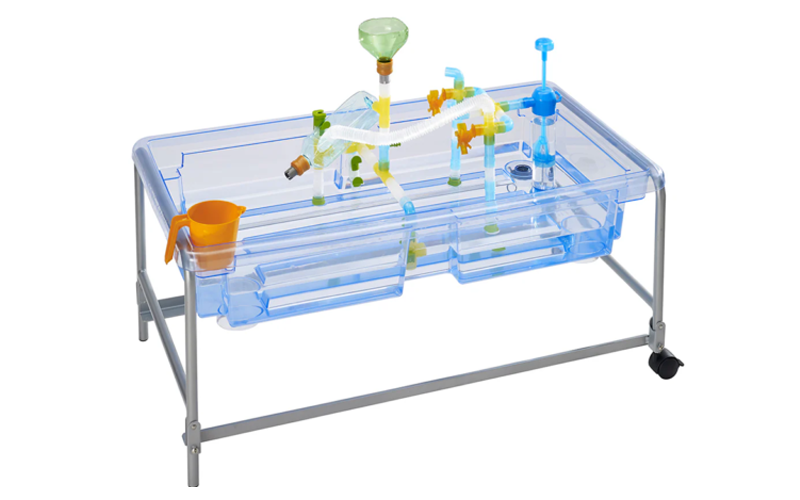
Transparent Acrylic Discovery Bin
Type: Visual Exploration Bin
Best for: Light tables, colored beads, glowing objects
Product Features:
- Fully transparent sides for visibility from all angles
- Compatible with light panels or natural sunlight
- Ideal for themes like space, glow-in-the-dark, or magnifying glass bins
- Promotes color recognition, light exploration, and focused attention
- Lightweight and stackable for easy classroom storage
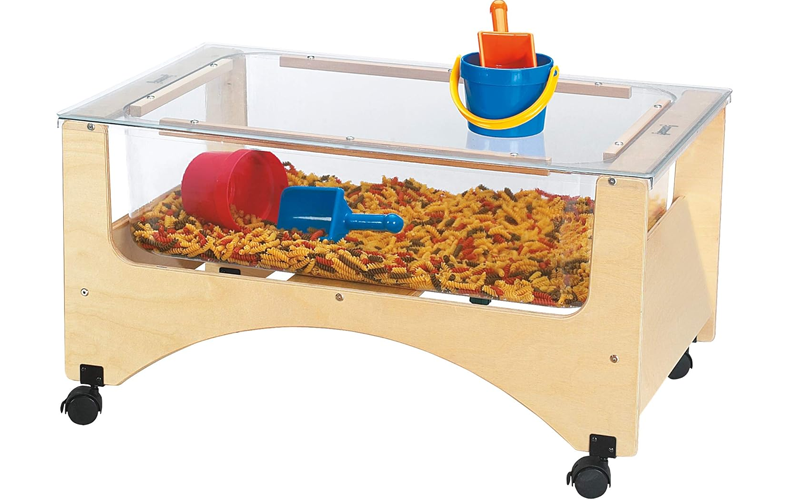
Mobile Sensory Bin Cart with Locking Wheels
Type: Rotational/Multi-bin Activity Station
Best for: Multi-theme switching, classroom group play
Product Features:
- Comes with 3–4 interchangeable bins on a metal frame
- Lockable wheels for safety and mobility
- Suitable for switching between dry, wet, and textured activities
- Perfect for busy kindergarten classrooms or shared learning spaces
- Promotes collaborative play and station-based rotation learning
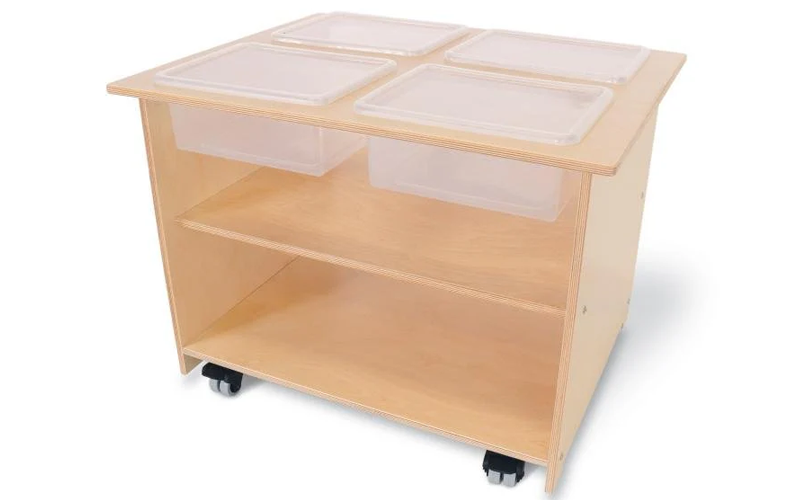
문의 사항이나 견적 요청이 있으시면 메시지를 보내주세요. 저희 전문가가 48시간 이내에 답변해 드리고, 원하시는 제품을 선택하실 수 있도록 도와드리겠습니다.
Safety Tips When Using Sensory Bins for Toddlers
Sensory Bins for Toddlers are potent tools for early development—but as with any activity involving small parts, open-ended materials, or physical interaction, safety must come first. Below are practical, experience-based safety tips and guidance for creating a safe and supportive sensory play environment for toddlers.
Always Supervise Play
The number one rule when using Sensory Bins for Toddlers is constant adult supervision. Toddlers are naturally curious and often explore by putting objects into their mouths. Even if the materials appear safe, items like beads, rice, or small toys can become choking hazards. An adult should always be present to observe, guide, and intervene if necessary. Supervision doesn’t mean hovering, but instead staying close enough to redirect behaviors, offer vocabulary, and ensure a calm, purposeful play environment.
Choose Age-Appropriate Materials
One of the most overlooked aspects of safety is material selection. What works for a 4-year-old may not be suitable for a younger toddler. For children under 3, avoid small parts, hard items with sharp edges, or anything that could splinter, break, or be swallowed. Stick to larger, edible-safe, or taste-safe items when in doubt. Examples include cooked pasta, edible dough, or puffed rice. If you’re using filler materials like chickpeas or beans, ensure they’re dry, not too small, and that children understand they’re for play only, not eating.
Keep Allergen Awareness in Mind
Many familiar Sensory Bins for Toddlers involve ingredients like flour, oats, or cornstarch. These may seem harmless, but some children may have allergies to wheat, legumes, or even certain soaps used in sensory foam. Always check with families or caregivers before introducing new materials. Clearly label bins if used in group settings, and create a list of potential allergens to keep on hand.
Prepare the Environment
A safe sensory experience requires a well-prepared environment. Choose a space that can handle mess, such as a tiled area, a washable mat, or a plastic table covering. Avoid placing bins near electrical outlets, carpeted areas, or furniture that could be stained. If using water or messy substances, have towels nearby and set boundaries: bins stay on the floor or at the table. A stable, low-height sensory bin table for toddlers can help prevent spills and keep play at a safe level for the child.
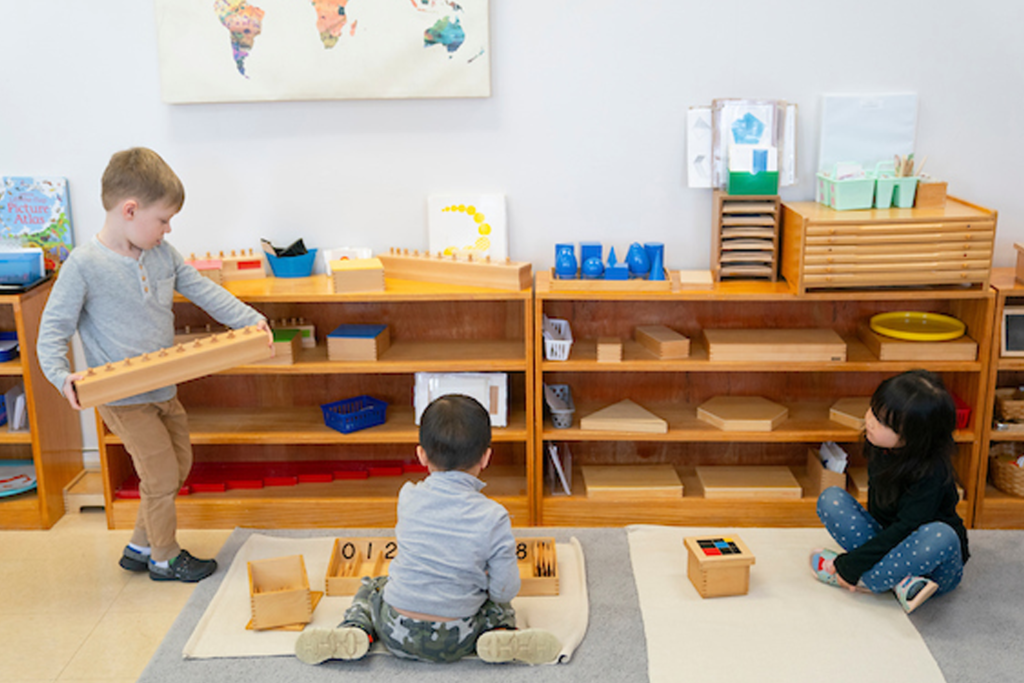
Introduce Clear Rules and Expectations
Toddlers thrive with structure. Before you open the bin, take a moment to review the rules. Keep it simple: “We don’t eat the rice,” “We use scoops, not our mouths,” or “We keep everything inside the bin.” By setting these expectations early and reinforcing them consistently, children learn how to engage safely and respectfully. Over time, these routines become second nature, promoting independence and responsibility during sensory bin activities.
Sanitize and Rotate Materials Regularly
Hygiene is a significant safety consideration, especially for toddlers who still mouth objects or touch their faces frequently. Reusable items like scoops, containers, or plastic toys should be washed after each session. Natural materials (e.g., rice, beans, sand) should be replaced regularly to avoid mold, bacteria, or pest buildup. For shared classroom use, rotating bins weekly can minimize cross-contamination and keep the experience fresh and exciting.
Observe and Adjust for Each Child’s Needs
Finally, remember that no two toddlers are the same. Some children may be overwhelmed by loud textures like crunchy pasta or cold water. Others may avoid wet or sticky materials. Watch how each child reacts to different Sensory Bins for Toddlers and adapt accordingly. Offer alternatives, allow choices, and never force a child to touch something that causes discomfort. A bin should invite exploration, not trigger stress.
자주 묻는 질문
1. What age is appropriate for using Sensory Bins for Toddlers?
Sensory Bins for Toddlers are typically suitable for children aged 12 months and older, depending on their developmental stage. For younger toddlers (under 3 years old), materials should be taste-safe, large enough to avoid choking hazards, and always used under adult supervision. As children grow, bins can include more complex tools, textures, and sorting challenges to match their fine motor skills and cognitive development.
2. What materials are safe to include in Sensory Bins for Toddlers?
Safe materials depend on the child’s age and allergy status. Standard toddler-safe options include dry oats, cooked pasta, edible dough, water, shredded paper, and large foam letters. For older toddlers, you can use rice, beans, chickpeas, and kinetic sand. Always avoid small parts for children under 3, and double-check for food or environmental allergies before introducing any new material into your sensory bin activities.
3. How often should I change or clean the sensory bin contents?
It’s recommended to clean or rotate the contents of Sensory Bins for Toddlers regularly, especially if the materials are reusable and the bin is used frequently. Dry fillers like rice or beans can last for weeks if kept dry and covered after use. Wet or messy materials like foam, oobleck, or cooked pasta should be discarded after each session. Tools (scoops, cups, toys) should be washed after every use to maintain hygiene.
4. How do Sensory Bins for Toddlers support early development?
Sensory Bins for Toddlers support a wide range of developmental areas. They strengthen fine motor skills through scooping, pouring, and grasping. They also promote language development as children describe textures, objects, or actions. Sensory bins foster problem-solving, attention span, sorting skills, and imaginative play. Additionally, they provide calming sensory input, making them excellent tools for self-regulation and emotional development.
5. What are some tips to manage mess during sensory bin play?
To manage mess, place Sensory Bins for Toddlers in an easy-to-clean area, such as a tile floor, washable mat, or outside on a patio. Set clear boundaries before play begins (e.g., “Keep everything in the bin”). Use a low, stable sensory bin table or a large shallow tray. Keep towels or wipes nearby, especially for messy materials like foam, water, or pudding. Preparing the space is key to making cleanup quick and stress-free.
결론
Sensory Bins for Toddlers are more than just playful distractions—they are powerful, developmentally rich tools that support learning, creativity, and emotional growth in early childhood. From building fine motor skills to encouraging language and problem-solving, each bin offers toddlers a safe, hands-on way to explore the world around them. Whether you’re a parent, teacher, or early childhood provider, implementing sensory bins with care, structure, and imagination can transform simple materials into meaningful learning experiences. By choosing age-appropriate content, following safety best practices, and staying engaged during play, we give children the freedom to touch, sort, pour, scoop, and imagine—turning every bin into a moment of discovery.




